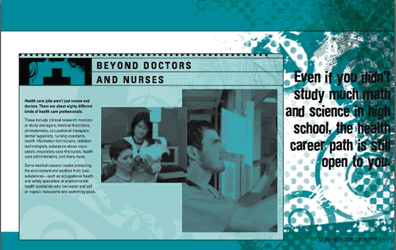Life After Graduation
It’s My Life!: A Guide to Alternatives After High School
Edited by Janine Schwab
American Friends Service Committee,
2008, 89 pages, $9.95
This book delivers post-high school jobs and internships you wished you knew about before you graduated, dropped out, or got kicked out of high school. Compiled and written by the American Friends Service Committee (AFSC), a Quaker peace and social justice organization, this book is a counter-recruiting tool. That purpose is powerfully subdued in this book that poses options and alternatives that outshine military service. Equally important, this book looks and reads like material for youth should—vibrant and compelling. The input from several youth organizations, including AFSC’s ORITA Program and NC Choices for Youth, is apparent.
What also come through strongly in this book are the alternatives to college. Many of us will never be able to do the amazing things in this book because we have so many school loans that must be paid. Getting into college is all the “guidance” counselors at high schools talk about. How sad that students should miss out on these opportunities just because their high schools want to be able to say that 100% of their graduates went on to college. The book also dispels the myth that the military can help pay for all that higher learning: “Military assistance for college is not free, not automatic, and not guaranteed on the enlistment contract.”
Youth who know that college isn’t the right choice at this time will be relieved to read the introduction to this book, which poses a series of questions: “Do you want to have an adventure? Work to save the environment? Work with animals? Learn new skills? Serve your country? Try out a career? Earn money for college?” The book provides descriptions and web addresses for most of the programs discussed. Who knew you could be an organic farming apprentice, learn to build boats, or get trained in an alternative fuels program? The websites vary in their clarity, so youth may have to send an email or spend a bit of time navigating the site to find out details. However, the possibilities offered are so refreshing compared to the usual rhetoric youth are handed (military, college, trade skills school) that young people are likely to take these new ideas and run with them.
It’s refreshing to see a nonjudgmental approach to both counter- recruiting and college alternatives that minimize personal debt. The book is extremely effective at showing an array of different jobs, adventures, or careers out there while making clear that you don’t have to choose now what you’re going to be for the rest of your life. The book also makes clear that the consequences of military service and college are not always reversible. Small sections throughout the book address some of the supposed benefits of military service, and there is information about the GI Rights Hotline, should a student choose to join (or leave) the military.

One concern is that this book is geared toward youth who are graduating from high school. While the military does target those people, they also target our so-called troublemakers, at-risk, or disenfranchised youth, who may have dropped out of high school or been arrested. The book consistently states how much each program pays its participants, so that youth with children or who don’t have a parent to send them an allowance would know whether the program provides more than just housing and food. But it doesn’t always address whether apprenticeships or training programs take people without a G.E.D. or with a criminal record. It remains up to young people with any of these issues to go to the websites or email the program coordinators and figure out whether they qualify.
One book cannot address all the ways in which the military appeals to young people, but it seems appropriate to contemplate whom this book is for. If it’s intended for youth who do well enough in school that they will be graduating, where will they find this book? It’s not likely to fit into school guidance counselors’ array of college and military brochures. On the other hand, if nonprofits and community organizations are working with youth who have dropped out, have children, have physical or mental health issues, use drugs, or are somehow involved in the criminal justice system, this book might not find a captive audience with them. The two pages devoted to getting shelter, meals, and transportation seem inadequate for the challenges youth face today. However, youth with all these issues still have goals, dreams, and desires, and this book speaks to all of those and provides a new lens through which to see the future.
Despite these minor shortcomings, every organization that works with youth should know about this book. AFSC has given away its 1,000 free copies, but the book is relatively affordable. As allies to young people, adults have a responsibility to provide options and support their choices. This is a great opportunity to do so. You might consider donating a copy to a nonprofit that works with youth, a place of worship that has a younger membership, or a library. As for all of those kids who are doing fine in high school and might not get to see this book in their guidance counselor’s office, think about those in your circle of friends and relatives who might be graduating soon.



